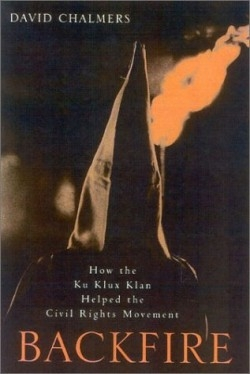It looks like you've stumbled upon a page meant to be read by our code instead of viewed directly. You're probably looking for this page.
Backfire
How the Ku Klux Klan Helped the Civil Rights Movement
In 1963, President Kennedy reflected that Alabama Governor George Wallace and the Ku Klux Klan aided the civil rights movement. The Klan’s brutality led to federal laws that aimed to protect all citizens from bombings, beatings, and murders, says Chalmers, an emeritus historian at the University of Florida and one of the foremost scholars of right-wing hate groups. These federal laws were passed during the 1960s, a time when Southern courts refused to indict Klan thugs who attacked peacefully protesting African-Americans.
By the end of the ’60s the Klan was suffering from a lack of leadership and was splintered into some twenty competing groups throughout the South. It was further weakened, the author notes, by such landmark pieces of legislation as the 1964 Civil Rights Act, the 1965 Voting Rights Act, and the 1968 Housing and Protection Act, all of which encouraged African-Americans to vote and to elect black officials.
The Klan experienced a resurgence during the late 1970s, as rural Southern whites were unwilling to accept the growing political clout of African-Americans; at the same time a deteriorating economy was moving low-level jobs overseas. Morris Dees, the founder of the Southern Poverty Law Center and one of the few heroes mentioned in this book, successfully prosecuted the few leftover vestiges of the Klan and some of the newly emerging hate groups, which were driven to financial ruin in court settlements.
This sobering and provocative investigation is more than a history of the civil rights movement, a topic Chalmers covered well in a previous book, And the Crooked Places Made Straight: The Struggle for Social Change in the 1960s*. Here he describes how Klan cells merged with right-wing skinhead, survivalist, and militia groups during the 1980s and 1990s. Unlike the Klan of the 1960s, which made African-Americans their primary targets, these new groups view the federal government and Jews, who the far right-wing believes are on a quest for world dominance, as the main threats to white America.
Chalmers does not provide in-depth portrayals of the hate groups and their members he exposes, but he does cover a wide array of cells and such notorious figures as Timothy McVeigh, whose 1995 bombing of the Murrah Federal Building in Oklahoma City resulted in the deaths of 168 people. The author’s account of the Klan’s always-lurking potential for mayhem is a chilling reminder that “there will always be a Klan as long as a would-be entrepreneur will…gather a group of…friends to drink beer, talk about guns and race, and ‘doin somethin’ about it.” The same disturbing description may also be applied to the newer hate groups.
Reviewed by
Karl Helicher
Disclosure: This article is not an endorsement, but a review. The publisher of this book provided free copies of the book to have their book reviewed by a professional reviewer. No fee was paid by the publisher for this review. Foreword Reviews only recommends books that we love. Foreword Magazine, Inc. is disclosing this in accordance with the Federal Trade Commission’s 16 CFR, Part 255.
